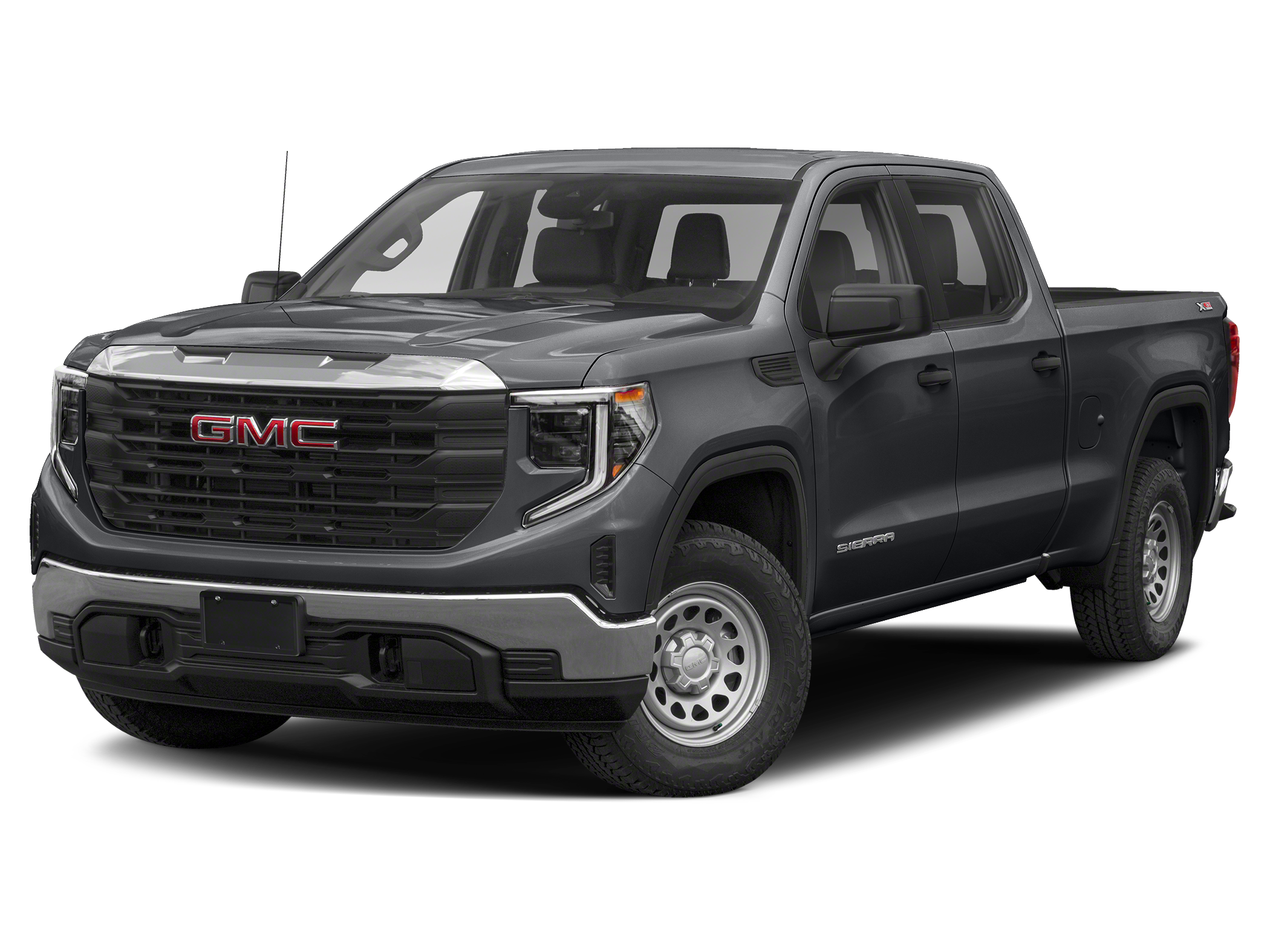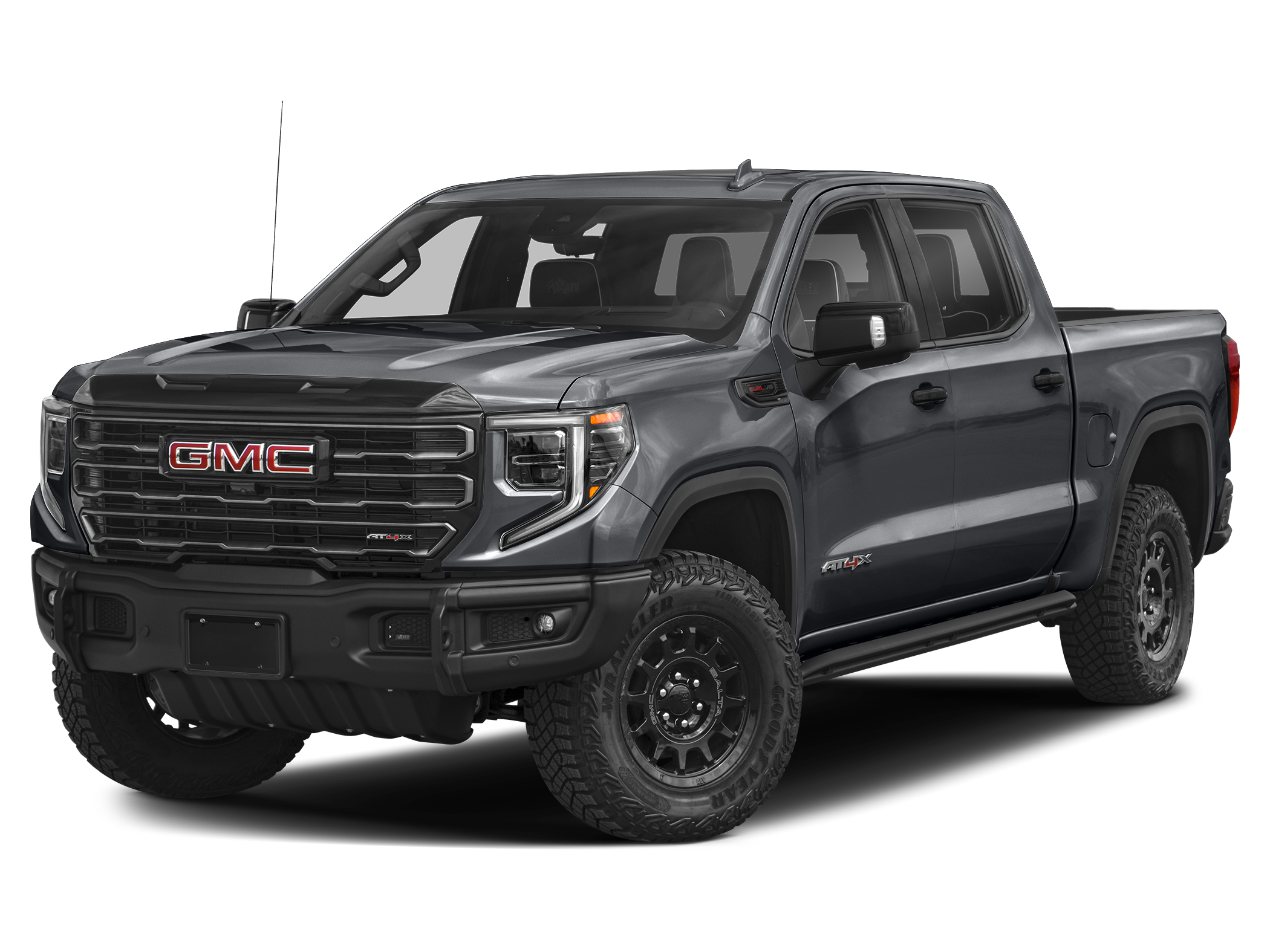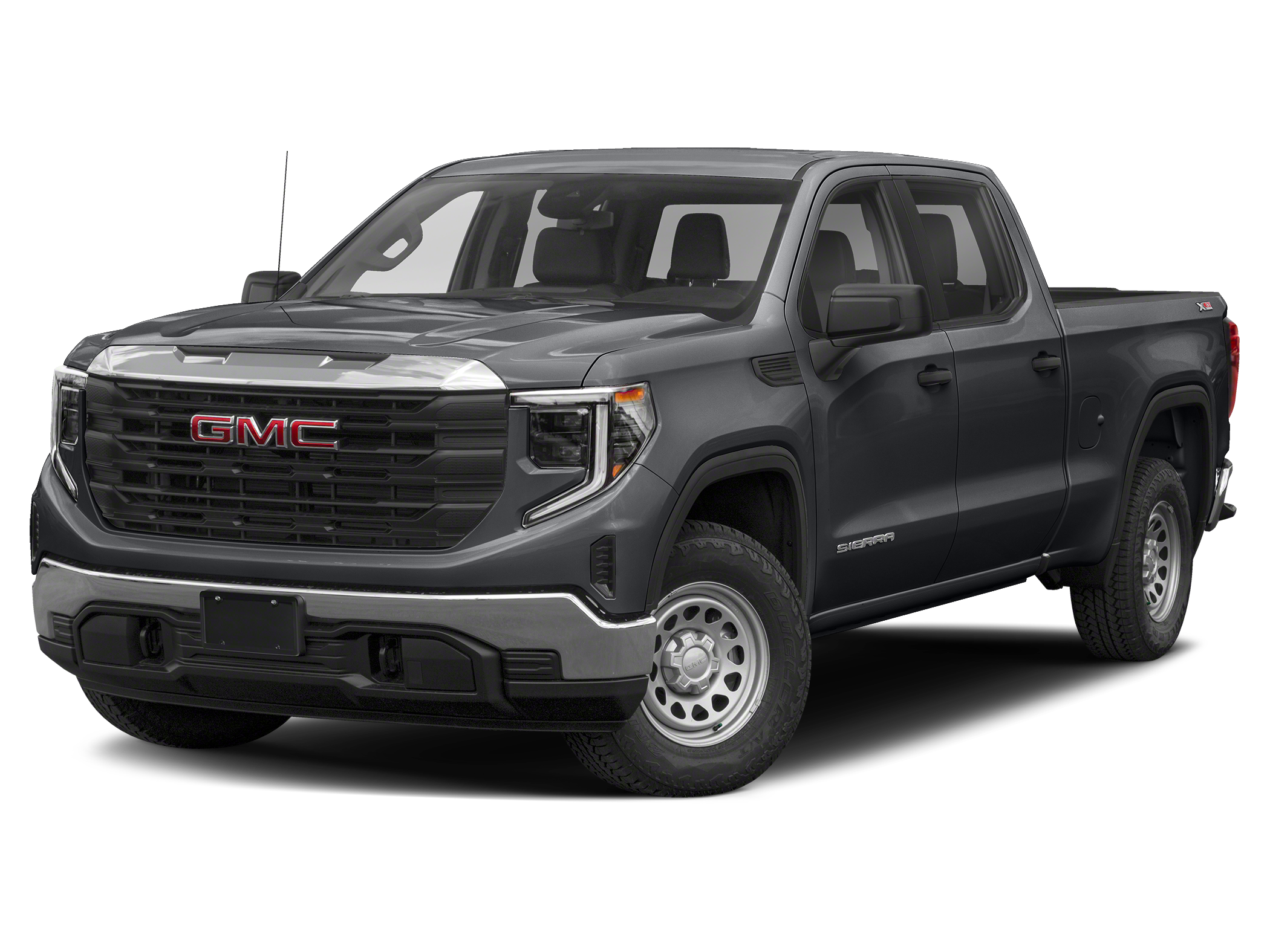REVIEWS AND RATINGS
What others are saying
REVIEW AND TEST DRIVE
2022 GMC Sierra 1500: When Change is a Good Thing
GMC solves the Sierra 1500's mid-life crisis with a significant overhaul.
Capital One
Trucks and SUVs remain a sales juggernaut in the United States, with nearly 75 percent of last year’s total vehicle sales attributed to what is collectively known as the light truck category. In actual units, that amounts to 11.6 million units versus 3.3 million units for cars. All in all, that’s a lot of sales that aren’t cars. So should we even feign surprise that the Ford F-150 pickup truck has been the best-selling vehicle in the U.S. for the last 40 years?
Indeed, there are other trucks for sale, right? Of course! Are they any good? Certainly! But Ford’s stronghold is, well, so strong that the best other models can hope for is a second-place finish. Last year, the Ram 1500 outsold the Chevrolet Silverado by about 40,000 units but was still more than 150,000 shy of the F-150. The Silverado’s twin, the GMC Sierra 1500, was far off the podium but still did a respectable nearly quarter-million units. But that’s less than half of the Silverado’s figure and a galaxy away from the F-150.
Nevertheless, competition in the light-duty pickup truck segment remains fierce. It’s a massive market with huge profit margins — who wouldn’t want in? And popularity contests aside, the models without Ford badges are definitely worth a look.
For example, consider the GMC Sierra 1500. Last redesigned for the 2019 model year, the 2022 GMC Sierra (and its Silverado sibling) receives a significant mid-cycle refresh. There are some styling updates, but the more significant changes occur within the cabin and include the introduction of two new trim levels. Joining the existing Pro, SLE, Elevation, SLT, AT4, and Denali are the AT4X and Denali Ultimate. Yes, the new trims are glorified versions of the already gung-ho AT4 and luxury-leaning Denali. But there is a method to this GMC madness.
Nearly half of the GMC portfolio contains trucks and SUVs wearing AT4 and Denali badges. Essentially, they are sub-brands for GMC, significant in their own right and boasting strong recognition amongst customers. By expanding these to AT4X and Denali Ultimate, GMC’s strategy is to further engage customers looking for premium models instead of common, readily available vehicles (cue the Chevy Silverado). In a sense, placing fourth in overall truck sales isn’t a failure when your target demographic is more affluent.
For this 2022 GMC Sierra 1500 review, I test-drove examples of the new Sierra AT4X and Sierra Denali Ultimate. Both trucks come standard in a crew cab/short box configuration with 4WD. They also include the Sierra’s most potent engine, a 6.2L V8 that produces 420 horsepower and 460 pound-feet of torque. However, you can option the Denali Ultimate with a 3.0L six-cylinder Duramax turbodiesel that produces 277 hp and 460 lb.-ft. of torque. Both engines are paired with a 10-speed automatic transmission.
 Beverly Braga
Beverly Braga
My Sierra Denali Ultimate test truck had Quicksilver Metallic paint ($495), a Cargo Convenience package ($535), premium front and rear floor liners ($130), and an Auxiliary Trailer Camera ($595), bringing the Manufacturer’s Suggested Retail Price (MSRP) to $84,450, including the $1,695 destination fee. The Sierra AT4X included Cayenne Red Metallic paint ($645), a Cargo Convenience package ($535), rocker guards ($1,150), and an Auxiliary Trailer Camera ($595), and carried an MSRP of $80,220.
GMC provided the vehicles for this Sierra review as part of a hosted media event in San Diego County. The automaker paid for airfare, lodging, and meals during the evaluation period.
2022 GMC Sierra 1500 Review: The Design
Exterior styling has been updated for the entire Sierra lineup but is limited to forward-facing attributes. Thanks to a revised front end and redesigned grilles, the Sierra looks larger and wider, though nothing changed dimensionally. New dual-projector LED headlights flank the expansive grille and feature a slimmer version of GMC’s signature split-C daytime running lights.
 Beverly Braga
Beverly Braga
The Sierra AT4 and AT4X grilles feature broad bars with black or dark nickel inserts, respectively, while the Denali’s triple-stack mesh grille design features what GMC calls a “tri-linear theme with cross-car chrome inserts.” It’s a convoluted way to say “larger chrome bars,” but, hey, I’m not in marketing. Dark, not-so-subtly-referenced “Vader” bars replace the bright chrome finish on the new Denali Ultimate.
Other than the grille coloring, the AT4 and AT4X are distinguished only with trim-specific badging. In the case of the AT4X, its hard-to-miss identifiers are on the grille, front door, tailgate, and within the truck bed. However, between the Denali and Denali Ultimate, you’d be hard-pressed to notice the differences. From the front, yes, it’s chrome versus Vader maws. But from the rear, the tailgate badge on the Denali Ultimate merely reads “Denali.” A profile shot also reveals another “Denali” emblem on the door. “Ultimate” appears only in one exterior location: a front fender badge that doubles as an engine size callout.
If positioned side-by-side, the high use of chrome on the Denali versus the lack of it on the Denali Ultimate will be a telltale sign. But when separated from the pack, the differences aren’t as noticeable. And if you’re paying upwards of 80 grand for either the AT4X or Denali Ultimate, I’d venture a guess that you’d want more visual affirmations of your best-of-the-best Sierra purchase.
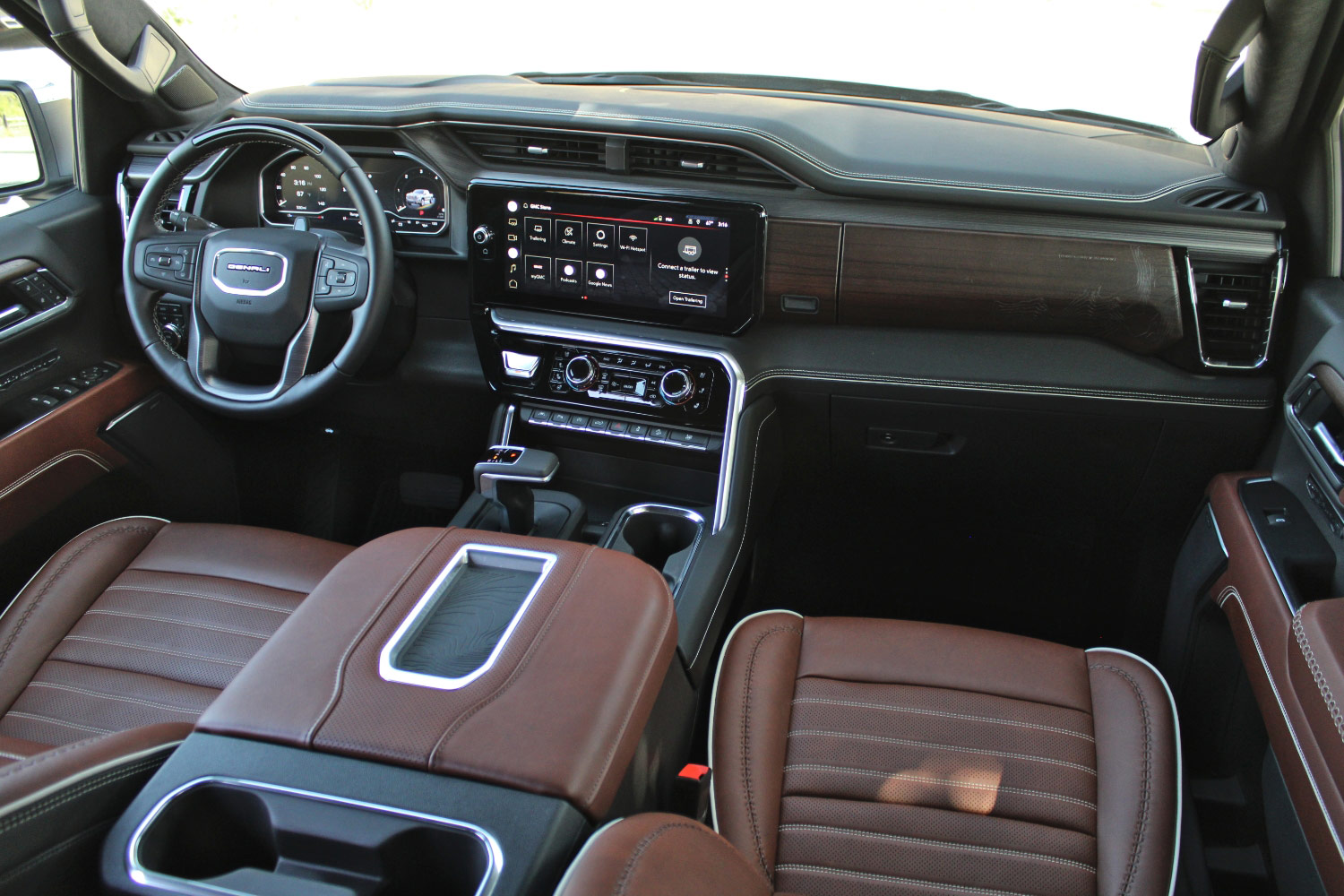 Beverly Braga
Beverly Braga
GMC hides the high-capability and high-luxury evidence within the interior. Nearly all Sierra models get an updated interior with a completely redesigned dashboard layout. Like the exterior, the interior, particularly the dash, is restyled to seem larger, longer, and leaner even though the measurements remain the same. Yes, the 13.4-inch infotainment system display plays a role in the optical illusion, but so does an overall design focused on straight, window-to-window horizontal lines rather than the multitude of rounded edges and shapes that filled the previous model year’s cabin (which remains in the Sierra Pro).
In the Sierra Denali Ultimate, the Alpine Umber interior is comfortably plush with soft, supple full-grain leather upholstery with unique contrast stitching. The seats, the armrests, the door inserts — you are absolutely spoiled. Also, the perforated leather front seats are embossed with topographical maps of Denali. Open-pore Paldao wood panels compliment the leather and also feature laser-etched maps. Denalis also feature bright metal speaker covers and badging.
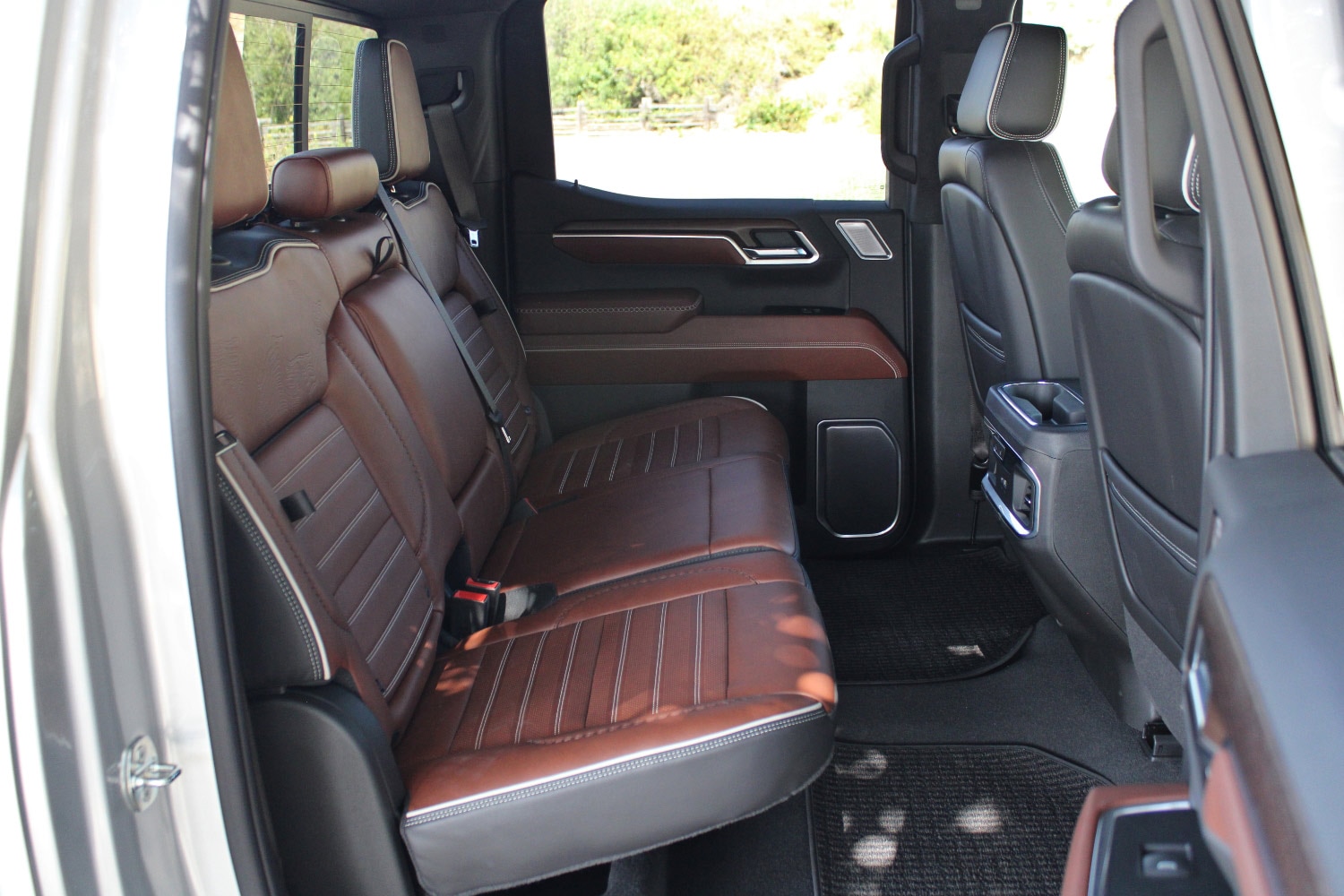 Beverly Braga
Beverly Braga
GMC decks out the Sierra AT4X cabin in an Obsidian Rush color scheme. The darker theme means the chrome bits in other trim levels are tinted black in the AT4X. This trim still treats you to the same full-grain leather found in the Denali Ultimate, paired with authentic wood of the Vanta Ash variety. But, strangely, the AT4X’s interior looks and feels less lavish. The red-and-black design of the perforated leather seat inserts comes off as cheap, as well as the “technical” leather grain pattern of the seat bolsters and the center console bin tip.
Both new trims feature 16-way power-adjustable front seats with a massage function. And for an added high-end atmosphere, the Denali Ultimate and AT4X have simulated suede on the headliner and the roof pillars. For those of smaller stature, entering and exiting the Sierra Denali Ultimate is easier thanks to its standard power assist side steps. However, the Sierra doesn’t offer adjustable pedals, which are available in the segment-king Ford F-150.
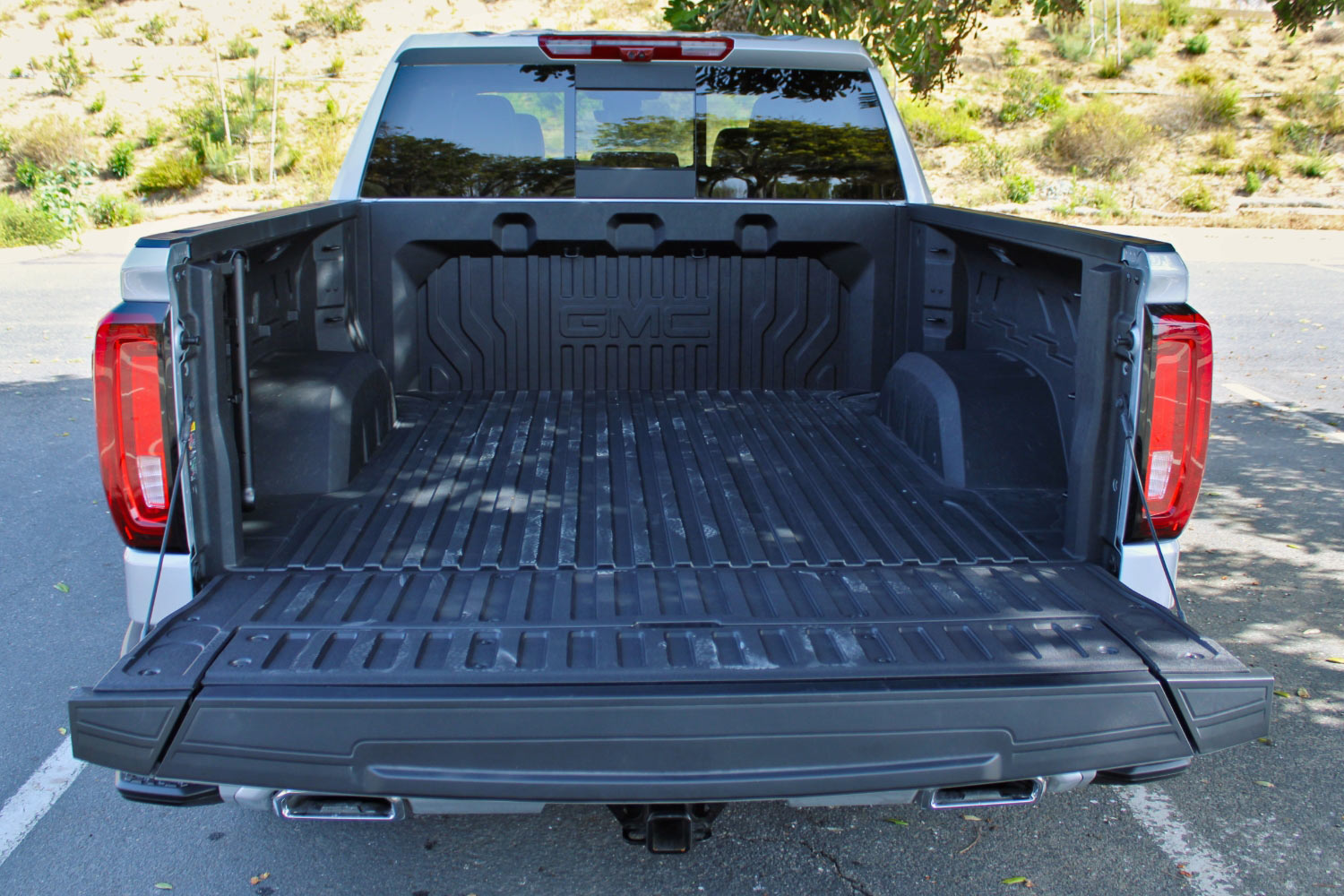 Beverly Braga
Beverly Braga
Overall, the GMC Sierra lineup does excel in overall spaciousness, comfort, and storage. If you have stuff, there’s a cubby for it, like the two gloveboxes, a deep center console bin, massive door pockets, under-seat storage, and even hidden compartments built into the rear seats. So “Where do I put this?” becomes less of a concern than “Where did I put that?”
2022 GMC Sierra 1500 Review: The Technology
One of the critical updates to the 2022 Sierra is the technology, ergo, more screens and bigger ones. According to GMC, the new Sierra has up to 40 inches of total display screen acreage. In 2022, most Sierras have a 13.4-inch infotainment touchscreen and a 12.3-inch digital instrumentation panel. In addition, a 15-inch multi-color head-up display is optional. Only the base Sierra Pro continues with the old truck’s analog gauges and 7-inch infotainment touchscreen.
 Beverly Braga
Beverly Braga
In terms of connectivity services, all Sierras with the 13.4-inch screen include a Google built-in system, which allows for seamless integration of Google Assistant, Google Maps, and Google Play. The tech is compatible with both Android and Apple devices, and GMC bakes three years of complimentary service into the prices of AT4 and Denali models. When using Google Assistant, hands-free activation was as easy as asking, “Hey, Google?” After that, using natural speech versus specific prompts made getting directions and changing control settings less frustrating, especially when driving.
Also, despite all of the screens, the display graphics are clean with easy-to-read fonts. While driving, the clearly labeled icons and responsive touchscreen made accessing and adjusting settings a breeze. Everything is entirely customizable, too, particularly on the infotainment display. For example, while towing, you can have both navigation and trailering details appear side by side or have a single data page on the screen, whether it be music, navigation, call history, vehicle status, you name it.
There are some caveats. If you’re using Google Maps via Apple CarPlay, be wary that the in-car navigation and synced phone maps look identical because you’re using the same Google-based software. This situation created some confusion when toggling in and out of certain display pages because I thought I’d lost my directions when, in reality, they were on a different navigation screen. I frequently found myself hitting Home to find the navigation icon I wanted. Eventually, I disconnected CarPlay because I found the built-in system faster and more accurate than my smartphone app.
Another thing worth noting is that the 40 inches of screen space don’t appear to minimize the number of buttons and knobs in the cabin, of which there are many. It’s as if GMC simply installed larger screens without doing anything to delete extraneous knobs or create multifunctional ones. This approach also creates some weird ergonomics, visually and physically.
For instance, the controls for 4WD settings are in two different areas. GMC locates the settings for drive modes and 4HI/4LO to the left of the steering wheel. If you want to activate hill descent control or change the differentials, you’ll find those switches on the center console alongside the automatic engine stop/start disable button and the parking sensors. Why? To be fair, you’re likely to have off-road settings predetermined before you venture off into the wilderness. But it’s still a baffling setup.
Also baffling is the relatively low positioning of the digital cluster and center touchscreen. They’re not aligned at the same level because the center air vents are positioned atop the infotainment display, and the buttons for the climate controls are located farther down than before. This arrangement means your eyes are off the road for a longer period just to look at the touchscreen or toggle a control. Even if only for a millisecond longer, when you’re not looking at the road ahead, you’re simply not looking.
 Beverly Braga
Beverly Braga
Speaking of safety, the most significant addition to the Sierra’s list of advanced technologies is Super Cruise. Updates to the Level 2 semi-autonomous driving system for 2022 model-year vehicles include automatic lane changes, trailering capability, and an enhanced navigation display that highlights Super Cruise-compatible roads within the map display. (Owners of 2021 models with Super Cruise will get these features through over-the-air updates.)
Unfortunately, GMC offers Super Cruise only on Sierra Denali models. It’s standard on the Denali Ultimate and available on the Denali. Another unfortunate note is that I could only test the new hands-free driving system for two highway exits. This situation was not ideal, but the provided 25-mile drive route meandered through San Diego suburbia before joining the Interstate a mere three miles before my exit.
Fortunately, Super Cruise is an intuitive, easy-to-learn system, and I was able to sample a small taste of the updates. You turn on the adaptive cruise control to activate the system, center the truck in the lane, and push the steering wheel-mounted Super Cruise button. Once the steering wheel light bar turns green—voila!—you can turn on those massaging seats and rest your hands.
Super Cruise remains one of the least complicated semi-autonomous systems out there. Despite the onset of rush hour, with traffic of varying speeds all around me, the system managed acceleration and braking with a smoothness akin to a luxury car ride, except I was behind the wheel of a 5,000-pound pickup. Sadly, I couldn’t give the new lane-changing feature a try because of the increased volume of traffic.
The new Sierra features GMC Pro Safety, the automaker’s suite of advanced driver-assistance systems (ADAS). Standard features include Forward Collision Alert, Automatic Emergency Braking, Front Pedestrian Braking, Lane Keep Assist, a Following Distance Indicator, and IntelliBeam automatic headlights. You can also equip the Sierra with up to 14 camera views, which are especially handy while towing.
Available trailering-specific safety features include Trailer Side Blind Zone Alert, a blind-spot monitoring system that accounts for the length of the trailer when changing lanes, and the new-for-2022 Gross Combination Weight (GCW) Alert, which will signal if the truck is overloaded and exceeding the maximum weight it can safely carry. The adaptive cruise control is also tweaked to operate while towing a trailer.
Because of the changes to the 2022 Sierra, neither the Insurance Institute for Highway Safety (IIHS) nor the National Highway Traffic Safety Administration (NHTSA) offered complete ratings on the refreshed version of the truck when this review was published. Therefore, when performing your research, make sure you differentiate between the new 2022 Sierra and the old 2022 Sierra Limited. Scores for the Limited do not apply to the refreshed Sierra.
2022 GMC Sierra 1500 Review: The Drive
The AT4 and Denali models make up half of all Sierra sales, but the two trims couldn’t be more different. And the AT4X and Denali Ultimate are even farther apart with regards to comfort and capabilities.
 Beverly Braga
Beverly Braga
Again, I drove the Sierra Denali Ultimate only a short distance but based on that brief road test, I can attest that it is the Sierra with ultimate comfort. Its standard Denali Premium Suspension featuring Adaptive Ride Control makes you forget you’re driving a chunky pickup with 8 inches of ground clearance that rides on 22-inch chrome wheels as it soaks up road bumps and uneven pavement like a parched sponge. Basically, it doesn’t feel like a boat. But I wouldn’t take corners at speed because that’s where you’ll feel its true mass. Slow and steady clear those turns.
The 6.2L V8 engine isn’t new to the Sierra lineup, so acceleration is familiar: quick. The exhaust note is pretty nice, too. With the powerful V8, GMC says the Sierra can accelerate to 60 mph in 5.4 seconds. I didn’t have the opportunity to test those numbers, but I believe it. Mash on the throttle from a standing stop and expect some wheel hop because the truck is eager to get going. Big acceleration requires big braking power, though, which the Sierra has. The brake pedal is firm with responsive stopping ability.
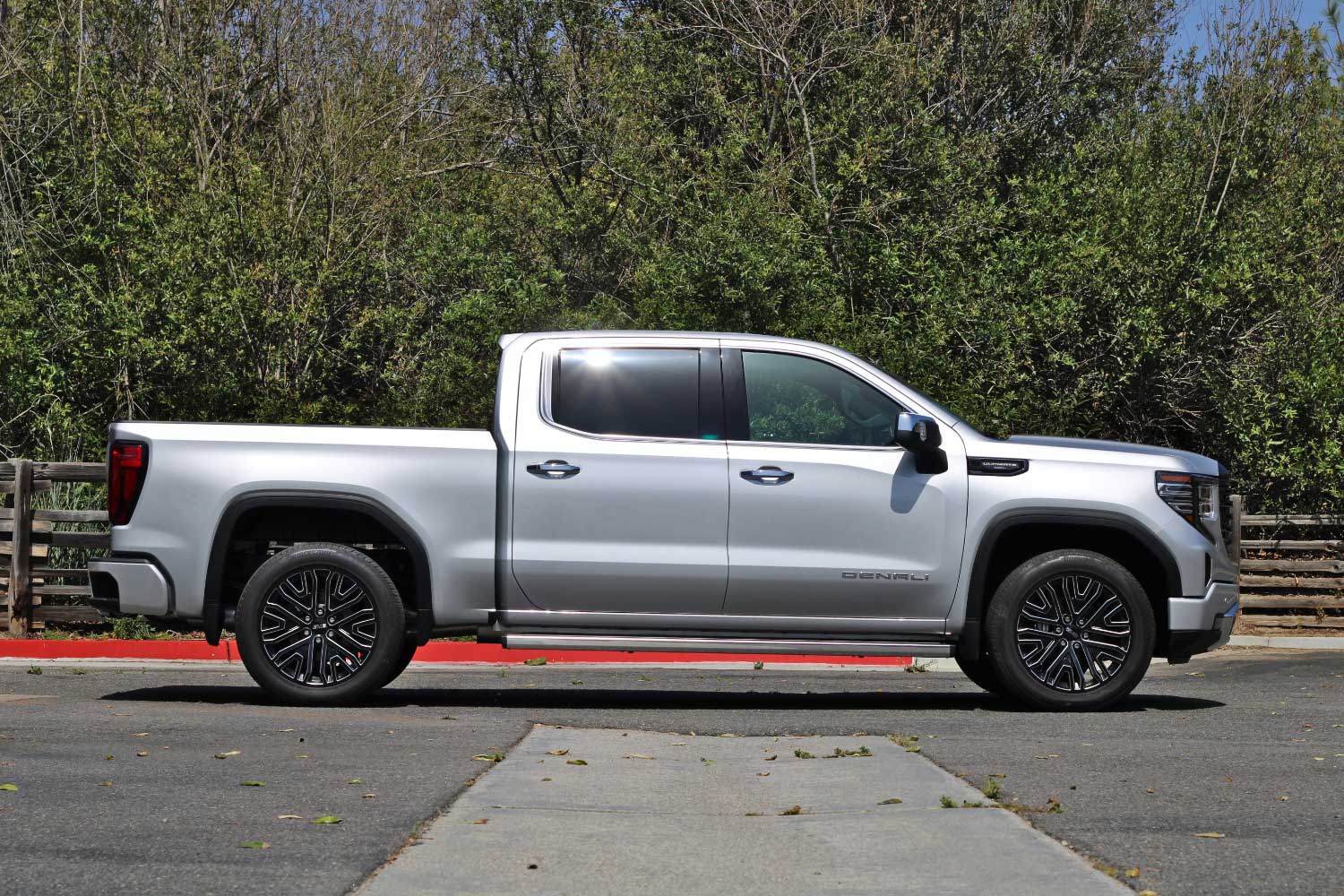 Beverly Braga
Beverly Braga
The same goes with the Sierra AT4X, which has the same drivetrain but without that extra level of poshness. That’s not to say that the AT4X is not an enjoyable highway cruiser because it very much is. Its lack of an adaptive air suspension is noticeable but not notable. With 11.1 inches of ground clearance and riding on 32-inch Goodyear Mud-Terrain tires, the AT4X’s on-road manners were surprisingly pleasant, and it does a decent job isolating road noise. The cabin isn’t library-level silent, but the din is quieter than expected given its wheel-and-tire package. For a purpose-built pickup truck, the AT4X can easily play the role of a comfortable daily driver.
Now, where GMC outfits the Denali Ultimate with luxury leanings, the AT4X receives appropriate off-road fixings. For starters, exclusive to the AT4X are Multimatic DSSV dampers and specialized springs that increase the wheel travel by 2 inches in the front and 1 inch in the rear compared to the AT4. That translates to 9.8 inches of suspension travel up front and 10.6 inches out back. GMC also calibrates the AT4X chassis and suspension for off-road adventures, equips the truck with a larger steel skid plate over the transfer case, and adds a Terrain driving mode.
Most impressive is that the Sierra AT4X has standard front and rear electronic locking differentials. Other than its Silverado sibling, no other light-duty pickup offers a front e-locker. You’ll find limited-slip differentials on competitors but not an electronic locker. And I was able to utilize all of the above during a drive through Anza-Borrego Desert State Park, where the main attraction was the Diablo Drop-Off.
 Beverly Braga
Beverly Braga
To get there, though, I aired the truck’s tires down to 25 psi. That improves traction on the rocky desert roads by allowing the tires to mold themselves to the uneven surfaces better than a fully-inflated tire. Less resistance means better grip, even when there’s no actual asphalt involved. En route to the drop-off, I ran the truck in the Off-Road drive mode with the transfer case in 4HI.
Off-Road and Terrain sound similar but are completely different settings. For example, off-Road allows more sliding and fewer electronic-nanny interferences. On the other hand, Terrain operates similar to hill descent control in that it allows for one-pedal driving in either 4HI or 4LO. In fact, because of the similarities, you can’t activate Terrain mode and hill descent control simultaneously.
 Beverly Braga
Beverly Braga
As part of a convoy, I maneuvered through the ungroomed terrain of washboard roads, silt beds, surprise ditches, and slotted canyons. And the Sierra AT4X powered through like these were no big deal. However, the Diablo Drop-Off actually challenged the truck because the famed devil’s edge is as steep as it is technical. The eroded ledge is a 45-degree, 100-foot drop that features a wide section full of deep pockets, soft sand, and hard ruts, while another narrower area offers a staircase-like adventure. The AT4X does boast the best approach and breakover angles of all the Sierra crew cabs, at 25.5 degrees and 22.7 degrees, respectively. However, its 23-degree departure angle is one of the lowest, which it shares with the AT4.
Nevertheless, I proceeded down the wider, off-camber road with the AT4X set to 4LO and the rear e-locker turned on. The AT4X’s extra suspension travel proved more than beneficial, as did the optional rocker guards, while I proceeded down what amounted to mini canyons causing unavoidable underbody scraping sounds. For the stepped section, both e-lockers were active, but the AT4X climbed up with little fuss.
As impressive as this sounds, don’t mistake the AT4X as a competitor to high-powered desert racers like the Ford F-150 Raptor and Ram TRX. On the contrary, the Sierra AT4X is a slow-burn kind of truck that prefers low-speed crawling to the high-speed adrenaline of Baja circuits. Anza-Borrego was a fun off-road portion of the day, but outside of the Diablo Drop-Off, nothing else during the desert drive gave the AT4X much of a fight. And I was expecting more from those behind-the-wheel ringside seats.
Is the 2022 GMC Sierra 1500 a Good Truck?
Though NHTSA and the IIHS haven’t released crash test ratings, the refreshed 2022 Sierra 1500 is a much better truck than it was before. It looks better, it feels better, the technology is better, and in many respects, it performs better. The one omission in the Sierra lineup is a proper performance truck to rival models from Ford and Ram, but if you’re not looking for a widebody desert racer, then the Sierra has a lot to offer. Maybe GMC will finally move the needle enough to close in a bit on the heavy-hitters in the full-size, light-duty pickup truck segment.
Written by humans.
Edited by humans.
 Beverly Braga
Beverly BragaBeverly Braga is a freelance writer and consultant with nearly 20 years of experience as a storyteller and communications professional. Her work has appeared in numerous print and digital outlets covering the automotive, entertainment, lifestyle, as well as food and beverage industries.





